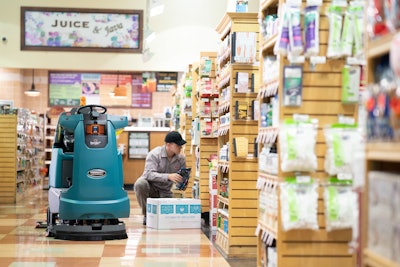
Stay at home, wash your hands and flatten the curve.
These messages have echoed across news channels, social media platforms and TV commercials ever since the COVID-19 outbreak. Nearly everything we do on a daily basis has changed, from socializing to shopping for basic necessities. Millions of Americans now work remotely from the safety of their homes, and it’s likely that in-office work will not return to pre-pandemic levels any time soon.
But, for essential workers such as grocery retail employees, working from home hasn’t been an option.
Grocery retail employees still interact with hundreds of customers a day, which puts them and anyone they come in contact with at risk of contracting and spreading COVID-19. In efforts to protect their employees and shoppers and help them feel safe, essential businesses follow cleanliness guidelines to minimize opportunities for transmission. But, enforcing the use of masks and sanitizers isn’t enough, and new intensive cleaning processes add to the burdens of already overwhelmed workers.
COVID-19 has changed the grocery shopping experience. According to a C+R Research survey, 60% of American shoppers are “fearful” of shopping at grocery stores, 45% disinfect their groceries when they get home and 73% are shopping less at physical stores. Half of those surveyed also believed that the stores should do more to keep employees safe, and one-third believed that more could be done to sanitize the stores.
Robotics helps to unlock cleaning efficiency so that stores can clean more and rebuild customer trust. Before the pandemic, many essential businesses were already using autonomous mobile robots (AMRs) to support their workers and optimize cleaning efficiency and consistency. These self-driving machines collectively conduct thousands of hours of floor cleaning that otherwise would have to be done by an essential worker after store hours. They are also capable of handling other critical tasks, like delivering inventory and scanning shelves for out-of-stock items and wrong or missing labels. Though normally only deployed during the night shift, robotic floor scrubbers are now being deployed during the day to ensure a constant state of clean for shoppers.
AMRs are intelligent and can safely avoid obstacles and people, and notify their human operator via text if they run into issues they cannot solve on their own. AMRs enable businesses to uphold high standards of cleanliness while providing essential workers with much-needed time to focus on other high-value tasks, such as sanitizing high-contact surfaces, restocking shelves, helping customers or taking breaks.
Automation can easily cut out the nitty-gritty, repetitive parts of work, but the durability and effectiveness of an AMR is directly tied to the quality of the machine and its software.
Recently, more and more businesses have turned to autonomous cleaning machines because they can be trained by anyone without the need for custom coding and complicated deployment processes, making them highly adaptable to the changing operating conditions of today’s stores.
Autonomous cleaning robots are projected to represent a lion’s share of global robotics in the near future. And cleaning robots are just the beginning—technology analysts predict that over 150,000 AMRs will be deployed in brick-and-mortar establishments by 2025, conducting daily cleaning, inventory management and material handling duties.
Right now, cleanliness is more important than ever. As states re-open, retailers will need all the help they can get to support their employees and help consumers feel safe while shopping. AMRs are already relied upon in thousands of grocery retail locations and warehouses across North America, helping workers maintain higher standards of cleanliness, productivity, and customer experience. This global pandemic is an opportunity to rely on them even more for the safety and well-being of essential workers and customers. In addition to filling labor gaps in essential industries, the presence of autonomous cleaning robots in grocery stores will help assuage fears of spreading disease and provide a strong visual reminder of grocers’ commitment to and investment in employee and customer health.




















